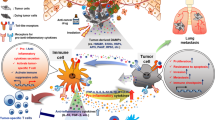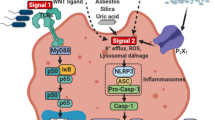Abstract
Accumulating evidence suggests that Toll-like receptor 4 (TLR4), a sensor for danger signals, is expressed not only in immune cells, but also in resident epithelial cells, and appears to participate in tissue homeostasis. To explain the premetastatic microenvironment created by the newly discovered endogenous TLR4 ligands, I propose a hypothesis of homeostatic inflammation that includes the classical danger hypothesis.
This is a preview of subscription content, access via your institution
Access options
Subscribe to this journal
Receive 12 digital issues and online access to articles
$119.00 per year
only $9.92 per issue
Buy this article
- Purchase on Springer Link
- Instant access to full article PDF
Prices may be subject to local taxes which are calculated during checkout


Similar content being viewed by others
References
Tsuji T, Ibaragi S, Hu GF . Epithelial-mesenchymal transition and cell cooperativity in metastasis. Cancer Res 2009; 69: 7135–7139.
Hiratsuka S, Watanabe A, Sakurai Y, Akashi-Takamura S, Ishibashi S, Miyake K et al. The S100A8-serum amyloid A3-TLR4 paracrine cascade establishes a pre-metastatic phase. Nat Cell Biol 2008; 10: 1349–1355.
Ehrchen JM, Sunderkötter C, Foell D, Vogl T, Roth J . The endogenous Toll-like receptor 4 agonist S100A8/S100A9 (calprotectin) as innate amplifier of infection, autoimmunity, and cancer. J Leuk Biol 2009; 86: 557–566.
Malle E, Sodin-Semrl S, Kovacevic A . Serum amyloid A: an acute-phase protein involved in tumour pathogenesis. Cell Mol Life Sci 2009; 66: 9–26.
McArdle SE, Rees RC . Tumor immunology: new perspectives. Cancer Res 2009; 69: 7157–7159.
Zhou L, Chong MM, Littman DR . Plasticity of CD4+ T cell lineage differentiation. Immunity 2009; 30: 646–655.
Maru Y . A concept of homeostatic inflammation provided by endogenous TLR4 Agonists that function before and after danger signal for metastasis. Antiinflammatory Antiallergy Agents Med Chem 2009; 8: 337–347.
Finak G, Bertos N, Pepin F, Sadekova S, Souleimanova M, Zhao H et al. Stromal gene expression predicts clinical outcome in breast cancer. Nat Med 2008; 14: 518–527.
Yi T, Chen Y, Wang L, Du G, Huang D, Zhao D et al. Reciprocal differentiation and tissue-specific pathogenesis of Th1, Th2, and Th17 cells in graft-versus-host disease. Blood 2009; 114: 3101–3112.
Curiel TJ, Coukos G, Zou L, Alvarez X, Cheng P, Mottram P et al. Specific recruitment of regulatory T cells in ovarian carcinoma fosters immune privilege and predicts reduced survival. Nat Med 2004; 10: 942–949.
Knutson KL, Lu H, Stone B, Reiman JM, Behrens MD, Prosperi CM et al. Immunoediting of cancers may lead to epithelial to mesenchymal transition. J Immunol 2006; 177: 1526–1533.
Li MO, Sanjabi S, Flavell RA . Transforming growth factor-β controls development, homeostasis, and tolerance of T cells by regulatory T cell-dependent and -independent mechanisms. Immunity 2006; 25: 455–471.
Dikov MM, Ohm JE, Ray N, Tchekneva EE, Burlison J, Moghanaki D et al. Differential roles of vascular endothelial growth factor receptors 1 and 2 in dendritic cell differentiation. J Immunol 2005; 174: 215–222.
Gordon S . Alternative activation of macrophages. Nat Rev Immunol 2003; 3: 23–35.
Kryczek I, Wei S, Zhu G, Myers L, Mottram P, Cheng P et al. Relationship between B7-H4, regulatory T cells, and patient outcome in human ovarian carcinoma. Cancer Res 2007; 67: 8900–8905.
Wang L, Liu Q, Sun Q, Zhang C, Chen T, Cao X . TLR4 signaling in cancer cells promotes chemoattraction of immature dendritic cells via autocrine CCL20. Biochem Biophys Res Commun 2008; 366: 852–856.
DeNardo DG, Barreto JB, Andreu P, Vasquez L, Tawfik D, Kolhatkar N et al. CD4+ T cells regulate pulmonary metastasis of mammary carcinomas by enhancing protumor properties of macrophages. Cancer Cell 2009; 16: 91–102.
Hagemann T, Lawrence T, McNeish I, Charles KA, Kulbe H, Thompson RG et al. “Re-educating” tumor-associated macrophages by targeting NF-κB. J Exp Med 2008; 205: 1261–1268.
Yang R, Cai Z, Zhang Y, Yutzy WH 4th, Roby KF, Roden RB . CD80 in immune suppression by mouse ovarian carcinoma-associated Gr-1+CD11b+ myeloid cells. Cancer Res 2006; 66: 6807–6815.
Delano MJ, Scumpia PO, Weinstein JS, Coco D, Nagaraj S, Kelly-Scumpia KM et al. MyD88-dependent expansion of an immature GR-1+CD11b+ population induces T cell suppression and Th2 polarization in sepsis. J Exp Med 2007; 204: 1463–1474.
Corzo CA, Cotter MJ, Cheng P, Cheng F, Kusmartsev S, Sotomayor E et al. Mechanism regulating reactive oxygen species in tumor-induced myeloid-derived suppressor cells. J Immunol 2009; 182: 5693–5701.
Zou L, Barnett B, Safah H, Larussa VF, Evdemon-Hogan M, Mottram P et al. Bone marrow is a reservoir for CD4+CD25+ regulatory T cells that traffic through CXCL12/CXCR4 signals. Cancer Res 2004; 64: 8451–8455.
Jaafar F, Righi E, Lindstrom V, Linton C, Nohadani M, van Noorden S et al. Correlation of CXCL12 expression and FoxP3+ cell infiltration with human papillomavirus infection and clinicopathological progression of cervical cancer. Am J Pathol 2009; 175: 1525–1535.
Maru Y . Logical structures extracted from metastasis experiments. Cancer Sci 2009; 100: 2006–2013.
Kaplan RN, Riba RD, Zacharoulis S, Bramley AH, Vincent L, Costa C et al. VEGFR1-positive haematopoietic bone marrow progenitors initiate the pre-metastatic niche. Nature 2005; 438: 820–827.
Zhang XH, Wang Q, Gerald W, Hudis CA, Norton L, Smid M et al. Latent bone metastasis in breast cancer tied to Src-dependent survival signals. Cancer Cell 2009; 16: 67–78.
Nguyen DX, Chiang AC, Zhang XH, Kim JY, Kris MG, Ladanyi M et al. WNT/TCF signaling through LEF1 and HOXB9 mediates lung adenocarcinoma metastasis. Cell 2009; 138: 51–62.
Podsypanina K, Du YC, Jechlinger M, Beverly LJ, Hambardzumyan D, Varmus H . Seeding and propagation of untransformed mouse mammary cells in the lung. Science 2008; 321: 1841–1844.
Huang Y, Song N, Ding Y, Yuan S, Li X, Cai H et al. Pulmonary vascular destabilization in the premetastatic phase facilitates lung metastasis. Cancer Res 2009; 69: 7529–7537.
Schnekenburger J, Schick V, Krüger B, Manitz MP, Sorg C, Nacken W et al. The calcium binding protein S100A9 is essential for pancreatic leukocyte infiltration and induces disruption of cell–cell contacts. J Cell Physiol 2008; 216: 558–567.
Vallon R, Freuler F, Desta-Tsedu N, Robeva A, Dawson J, Wenner P et al. Serum amyloid A (apoSAA) expression is up-regulated in rheumatoid arthritis and induces transcription of matrix metalloproteinases. J Immunol 2001; 166: 2801–2807.
Kim S, Takahashi H, Lin WW, Descargues P, Grivennikov S, Kim Y et al. Carcinoma-produced factors activate myeloid cells through TLR2 to stimulate metastasis. Nature 2009; 457: 102–106.
Maru Y . Activation of TLR4 in pre-metastatic phase: crosstalk with TNF. In: Proceedings of 12th International TNF Conference; 26–29 April 2009. Madrid, Spain.
Shojaei F, Wu X, Qu X, Kowanetz M, Yu L, Tan M et al. G-CSF-initiated myeloid cell mobilization and angiogenesis mediate tumor refractoriness to anti-VEGF therapy in mouse models. Proc Natl Acad Sci USA 2009; 106: 6742–6747.
Nagaraj S, Gabrilovich DI . Tumor escape mechanism governed by myeloid-derived suppressor cells. Cancer Res 2008; 68: 2561–2563.
Greifenberg V, Ribechini E, Rössner S, Lutz MB . Myeloid-derived suppressor cell activation by combined LPS and IFN-γ treatment impairs DC development. Eur J Immunol 2009; 39: 2865–2876.
Cheng P, Corzo CA, Luetteke N, Yu B, Nagaraj S, Bui MM et al. Inhibition of dendritic cell differentiation and accumulation of myeloid-derived suppressor cells in cancer is regulated by S100A9 protein. J Exp Med 2008; 205: 2235–2249.
Lamb RJ, Capocasale RJ, Duffy KE, Sarisky RT, Mbow ML . Identification and characterization of novel bone marrow myeloid DEC205+Gr-1+ cell subsets that differentially express chemokine and TLRs. J Immunol 2007; 178: 7833–7839.
Olkhanud PB, Baatar D, Bodogai M, Hakim F, Gress R, Anderson RL et al. Breast cancer lung metastasis requires expression of chemokine receptor CCR4 and regulatory T cells. Cancer Res 2009; 69: 5996–6004.
Taranova AG, Maldonado D III, Vachon CM, Jacobsen EA, Abdala-Valencia H, McGarry MP et al. Allergic pulmonary inflammation promotes the recruitment of circulating tumor cells to the lung. Cancer Res 2008; 68: 8582–8589.
Apetoh L, Ghiringhelli F, Tesniere A, Obeid M, Ortiz C, Criollo A et al. Toll-like receptor 4-dependent contribution of the immune system to anticancer chemotherapy and radiotherapy. Nat Med 2007; 13: 1050–1059.
Hammad H, Chieppa M, Perros F, Willart MA, Germain RN, Lambrecht BN . House dust mite allergen induces asthma via Toll-like receptor 4 triggering of airway structural cells. Nat Med 2009; 15: 410–416.
Wong AP, Keating A, Lu WY, Duchesneau P, Wang X, Sacher A et al. Identification of a bone marrow-derived epithelial-like population capable of repopulating injured mouse airway epithelium. J Clin Invest 2009; 119: 336–348.
Zhang X, Shan P, Jiang G, Cohn L, Lee PJ . Toll-like receptor 4 deficiency causes pulmonary emphysema. J Clin Invest 2006; 116: 3050–3059.
Jiang D, Liang J, Fan J, Yu S, Chen S, Luo Y et al. Regulation of lung injury and repair by Toll-like receptors and hyaluronan. Nat Med 2005; 11: 1173–1179.
Németh J, Stein I, Haag D, Riehl A, Longerich T, Horwitz E et al. S100A8 and S100A9 are novel nuclear factor kappa B target genes during malignant progression of murine and human liver carcinogenesis. Hepatology 2009; 50: 1251–1262.
Macagno A, Napolitani G, Lanzavecchia A, Sallusto F . Duration, combination and timing: the signal integration model of dendritic cell activation. Trends Immunol 2007; 28: 227–233.
Raquil MA, Anceriz N, Rouleau P, Tessier PA . Blockade of antimicrobial proteins S100A8 and S100A9 inhibits phagocyte migration to the alveoli in streptococcal pneumonia. J Immunol 2008; 180: 3366–3374.
Pouliot P, Plante I, Raquil MA, Tessier PA, Olivier M . Myeloid-related proteins rapidly modulate macrophage nitric oxide production during innate immune response. J Immunol 2008; 181: 3595–3601.
Lee SH, Park DW, Park SC, Park YK, Hong SY, Kim JR et al. Calcium-independent phospholipase A2β-Akt signaling is involved in lipopolysaccharide-induced NADPH oxidase 1 expression and foam cell formation. J Immunol 2009; 183: 7497–7504.
Park HS, Jung HY, Park EY, Kim J, Lee WJ, Bae YS . Cutting edge: direct interaction of TLR4 with NAD(P)H oxidase 4 isozyme is essential for lipopolysaccharide-induced production of reactive oxygen species and activation of NF-κB. J Immunol 2004; 173: 3589–3593.
Kim YS, Morgan MJ, Choksi S, Liu ZG . TNF-induced activation of the Nox1 NADPH oxidase and its role in the induction of necrotic cell death. Mol Cell 2007; 26: 675–687.
Auffray C, Fogg DK, Narni-Mancinelli E, Senechal B, Trouillet C, Saederup N et al . CX3CR1+ CD115+ CD135+ common macrophage/DC precursors and the role of CX3CR1 in their response to inflammation. J Exp Med 2009; 206: 595–606.
Lee WJ . Bacterial-modulated signaling pathways in gut homeostasis. Sci Signal 2008; 1: pe24.
Zheng L, Riehl T, Stenson WF . Regulation of colonic epithelial repair in mice by Toll-like receptors and hyaluronic acid. Gastroenterology 2009; in press.
Reigstad CS, Lundén GO, Felin J, Bäckhed F . Regulation of serum amyloid A3 (SAA3) in mouse colonic epithelium and adipose tissue by the intestinal microbiota. PLoS One 2009; 4: e5842.
Grivennikov S, Karin E, Terzic J, Mucida D, Yu GY, Vallabhapurapu S et al. IL-6 and Stat3 are required for survival of intestinal epithelial cells and development of colitis-associated cancer. Cancer Cell 2009; 15: 103–113.
Acknowledgements
I thank Dr Y. Sakurai, Dr T. Tomita and Dr F. Tsukahara, and Ms S. Ishibashi for help with experiments. This work was partly supported by Grants-in-Aid for Scientific Research from the Japanese government (No. 21117008) (homeostatic inflammation study group) to YM.
Author information
Authors and Affiliations
Corresponding author
Rights and permissions
About this article
Cite this article
Maru, Y. Premetastatic milieu explained by TLR4 agonist-mediated homeostatic inflammation. Cell Mol Immunol 7, 94–99 (2010). https://doi.org/10.1038/cmi.2009.113
Received:
Accepted:
Published:
Issue Date:
DOI: https://doi.org/10.1038/cmi.2009.113
Keywords
This article is cited by
-
Stimuli-induced Organ-specific Injury Enhancement of Organotropic Metastasis in a Spatiotemporal Regulation
Pathology & Oncology Research (2014)
-
Imbalance of Clara cell-mediated homeostatic inflammation is involved in lung metastasis
Oncogene (2011)



